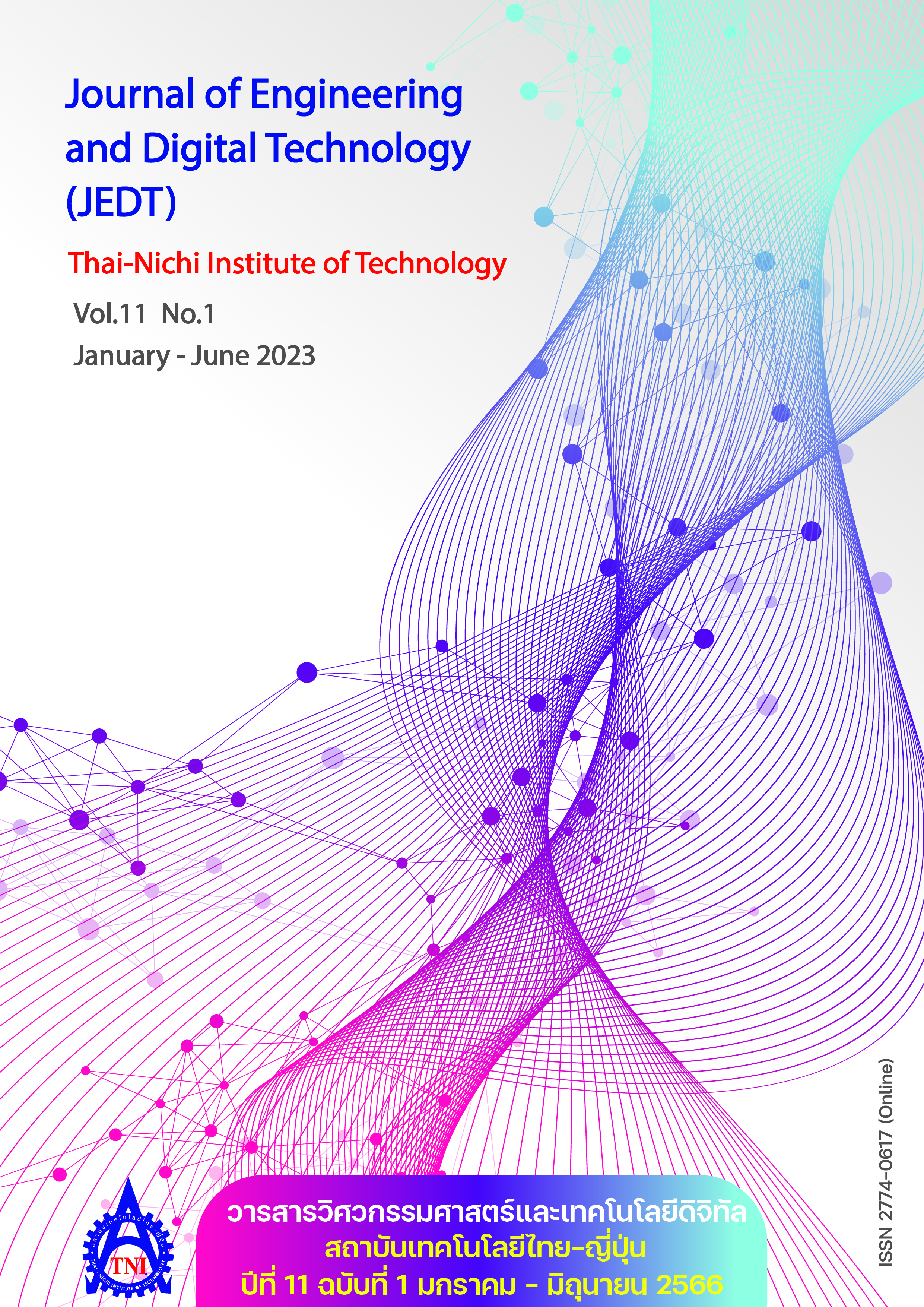การเลือกขนาดของโมดูลพีวี/ทีและถังเก็บน้ำเย็นสำหรับเครื่องผลิตน้ำร้อนปั๊มความร้อนเสริมพีวี/ที : กรณีศึกษาประเทศไทย
Main Article Content
บทคัดย่อ
ในงานวิจัยนี้ได้ศึกษาศักยภาพในการผลิตน้ำร้อนของปั๊มความร้อนแบบอัดไอทำงานร่วมกับโมดูลโฟโตวอลเทอิก/ความร้อน (พีวี/ที) โดยปั๊มความร้อนมีความสามารถในการทำความร้อนสูงสุดที่ 3,000 วัตต์ ทำหน้าที่ดึงความร้อนจากโมดูลพีวี/ที โดยแต่ละโมดูลสามารถผลิตกำลังไฟฟ้าสูงสุด 200 วัตต์ และมีพื้นที่รับรังสี 1.326 ม2 การศึกษาจะพิจารณาขนาดของโมดูลพีวี/ที และขนาดของถังน้ำเย็นที่เหมาะสมในการผลิตน้ำร้อนปริมาณ 350, 500 และ 700 ลิตร ให้มีอุณหภูมิน้ำแต่ละวัน 60 °C และพิจารณาปริมาณพลังงานความร้อน และไฟฟ้าที่ผลิตได้ เมื่อมีการเปลี่ยนแปลงจำนวนโมดูล และขนาดถังน้ำเย็น รวมถึงพลังงานไฟฟ้าจากระบบจำหน่ายที่สามารถประหยัดได้เทียบกับระบบทำน้ำร้อนที่ใช้ลวดไฟฟ้า ภายใต้สภาวะอากาศของจังหวัดเชียงใหม่ ขอนแก่น กรุงเทพฯ และสงขลา ผลการศึกษาพบว่าการผลิตน้ำร้อนปริมาณดังกล่าว ระบบสามารถประหยัดพลังงานไฟฟ้าจากระบบจำหน่ายได้มากกว่าร้อยละ 90, 90 และ 70 ตามลำดับ และเมื่อพิจารณาผลการวิเคราะห์ทางเศรษฐศาสตร์ พบว่าจำนวนโมดูลพีวี/ทีที่เหมาะสมจะอยู่ที่ 8, 8 และ 10 โมดูล ตามลำดับ โดยมีขนาดถังน้ำเย็นที่ 300, 300 และ 50 ลิตร ตามลำดับ ทั้งนี้ระยะเวลาคืนทุนเฉลี่ยอยู่ที่ 5.70, 3.95 และ 4.83 ปี ตามลำดับ
Article Details

This work is licensed under a Creative Commons Attribution-NonCommercial-NoDerivatives 4.0 International License.
นโยบายการรับบทความ
กองบรรณาธิการวารสารสถาบันเทคโนโลยีไทย-ญี่ปุ่น มีความยินดีรับบทความจากอาจารย์ประจำ และผู้ทรงคุณวุฒิในสาขาวิศวกรรมศาสตร์และเทคโนโลยี ที่เขียนเป็นภาษาไทยหรือภาษาอังกฤษ ซึ่งผลงานวิชาการที่ส่งมาขอตีพิมพ์ต้องไม่เคยเผยแพร่ในสิ่งพิมพ์อื่นใดมาก่อน และต้องไม่อยู่ในระหว่างการพิจารณาของวารสารอื่นที่นำส่ง ดังนั้นผู้สนใจที่จะร่วมเผยแพร่ผลงานและความรู้ที่ศึกษามาสามารถนำส่งบทความได้ที่กองบรรณาธิการเพื่อเสนอต่อคณะกรรมการกลั่นกรองบทความพิจารณาจัดพิมพ์ในวารสารต่อไป ทั้งนี้บทความที่สามารถเผยแพร่ได้ประกอบด้วยบทความวิจัย ผู้สนใจสามารถศึกษาและจัดเตรียมบทความจากคำแนะนำสำหรับผู้เขียนบทความ
การละเมิดลิขสิทธิ์ถือเป็นความรับผิดชอบของผู้ส่งบทความโดยตรง บทความที่ได้รับการตีพิมพ์ต้องผ่านการพิจารณากลั่นกรองคุณภาพจากผู้ทรงคุณวุฒิและได้รับความเห็นชอบจากกองบรรณาธิการ
ข้อความที่ปรากฏภายในบทความของแต่ละบทความที่ตีพิมพ์ในวารสารวิชาการเล่มนี้ เป็น ความคิดเห็นส่วนตัวของผู้เขียนแต่ละท่าน ไม่เกี่ยวข้องกับสถาบันเทคโนโลยีไทย-ญี่ปุ่น และคณาจารย์ท่านอื่น ๆ ในสถาบัน แต่อย่างใด ความรับผิดชอบด้านเนื้อหาและการตรวจร่างบทความแต่ละบทความเป็นของผู้เขียนแต่ละท่าน หากมีความผิดพลาดใด ๆ ผู้เขียนแต่ละท่านจะต้องรับผิดชอบบทความของตนเองแต่ผู้เดียว
กองบรรณาธิการขอสงวนสิทธิ์มิให้นำเนื้อหา ทัศนะ หรือข้อคิดเห็นใด ๆ ของบทความในวารสารสถาบันเทคโนโลยีไทย-ญี่ปุ่น ไปเผยแพร่ก่อนได้รับอนุญาตจากผู้นิพนธ์ อย่างเป็นลายลักษณ์อักษร ผลงานที่ได้รับการตีพิมพ์ถือเป็นลิขสิทธิ์ของวารสารสถาบันเทคโนโลยีไทย-ญี่ปุ่น
ผู้ประสงค์จะส่งบทความเพื่อตีพิมพ์ในวารสารวิชาการ สถาบันเทคโนโลยีไทย-ญี่ปุ่น สามารถส่ง Online ที่ https://www.tci-thaijo.org/index.php/TNIJournal/ โปรดสมัครสมาชิก (Register) โดยกรอกรายละเอียดให้ครบถ้วนหากต้องการสอบถามข้อมูลเพิ่มเติมที่
- กองบรรณาธิการ วารสารสถาบันเทคโนโลยีไทย-ญี่ปุ่น
- ฝ่ายวิจัยและนวัตกรรม สถาบันเทคโนโลยีไทย-ญี่ปุ่น
เลขที่ 1771/1 สถาบันเทคโนโลยีไทย-ญี่ปุ่น ซอยพัฒนาการ 37-39 ถนนพัฒนาการ แขวงสวนหลวง เขตสวนหลวง กรุงเทพมหานคร 10250 ติดต่อกับคุณพิมพ์รต พิพัฒนกุล (02) 763-2752 , คุณจุฑามาศ ประสพสันติ์ (02) 763-2600 Ext. 2402 Fax. (02) 763-2754 หรือ E-mail: JEDT@tni.ac.th
References
A. N. Karakilic, A. Karafil, and N. Gene, “Effects of temperature and solar irradiation on performance of monocrystalline, polycrystalline and thin-film PV panels,” IJTPE, vol. 14, no. 2, pp. 254–260, Jun. 2022.
T. Lungkadee and A. Asanakham, “Evaluation of electrical power and temperature of solar rooftop module by air cooling with augmented fin,” Eng. J. Chiang Mai Univ., vol. 28, no. 3, pp. 130–141, 2016.
E. Wilson, “Theoretical and operational thermal performance of a wet crystalline silicon PV module under Jamaican conditions,” Renew. Energy, vol. 34, no. 6, pp. 1655–1660, Jun. 2009.
T. Kim, B. Choi, Y. Han, and K. Do, “A comparative investigation of solar-assisted heat pumps with solar thermal collectors for a hot water supply system,” Energy Convers. Manage., vol. 172, pp. 472–484, Sep. 2018.
M. A. Obalanlege, Y. Mahmoudi, R. Douglas, E. Ebrahimnia-Bajestan, J. Davidson, and D. Bailie, “Performance assessment of a hybrid photovoltaic-thermal and heat pump system for solar heating and electricity,” Renew. Energy, vol. 148, pp. 558–572, Apr. 2020.
S. Vaishak and P. V. Bhale, “Photovoltaic/thermal-solar assisted heat pump system: Current status and future prospects,” Sol. Energy, vol. 189, pp. 268–284, Sep. 2019.
M. Kosan, M. Demirtas, M. Aktas, and E. Disli, “Performance analyses of sustainable PV/T assisted heat pump drying system,” Sol. Energy, vol. 199, pp. 657–672, Mar. 2020.
E. Bellos, C. Tzivanidis, K. Moschos, and K. A. Antonopoulos, “Energetic and financial evaluation of solar assisted heat pump space heating systems,” Energy Convers. Manage., vol. 120, pp. 306–319, Jul. 2016.
Y. Bai, T. T. Chow, C. Menezo, and P. Dupeyrat, “Analysis of a hybrid PV/Thermal solar-assisted heat pump system for sports center water heating application,” Int. J. Photoenergy, vol. 2012, Aug. 2012, Art. no. 265838, doi: 10.1155/2012/265838.
European Commission. “Photovoltaic geographical information systems.” EUROPA.eu. https://re.jrc.ec.europa.eu/pvg_tools/en/ (accessed Aug. 9, 2022).
V. Sun, A. Asanakham, T. Deethayat, and T. Kiatsiriroat, “A new method for evaluating nominal operating cell temperature (NOCT) of unglazed photovoltaic thermal module,” Energy Rep., vol. 6, pp. 1029–1042, Nov. 2020.
K. Utama, “Performance analysis of photovoltaic/thermal module with heat pump for heat and power,” M.S. thesis, Dept. Energy Eng., Chiang Mai Univ., Chiang Mai, Thailand, 2022.

